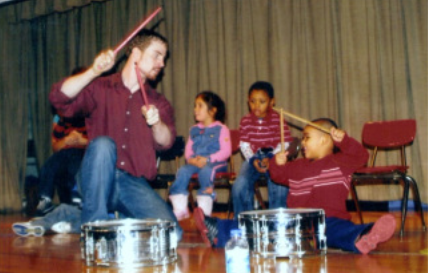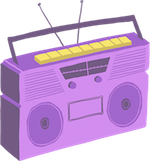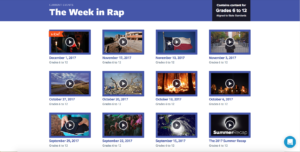
How Music Transforms Learning in the Classroom
When music plays, you just feel it. You begin tapping your foot or swaying. Maybe you start singing along or humming to yourself. You can’t help it. Even those with hearing impairments find themselves connecting to the rhythm as it throbs and vibrates in our bones and in our brains. Music is powerful. It evokes so much. When hearing the theme from “Friday the 13th“ or “Chariots of Fire“ we feel correspondingly apprehensive or inspired. Couples have their own breakup, make-up, and love songs that elicit corresponding memories and emotions.
I think everyone has an innate connection to music. My first serious instrument was the saxophone that I learned to play when I was in 4th grade. Before that, though, I had already formed a deep connection to music by listening to old record albums and 8-tracks with my mom. Yes, she still had a functioning 8-track player in the ’80s with music ranging from Iron Butterfly to John Denver. I’d borrow my brother’s tapes and CDs when he wasn’t looking.
One good thing about music, when it hits you, you feel no pain.
-Bob Marley
Apart from my personal love for music, it has played an important role in my professional life as well. I began my work in the New York City Department of Education as a music teacher in District 75 working with students with autism and emotional/behavioral challenges. For the latter group, music was a calming influence, a reward system, an engagement tool, and a language that bridged the boundaries of culture and life experience. For the students with autism, it could become a voice for students who struggled to have one.
What I mean by that is that I’ve had students who are barely verbal in a conversational context, but they were far more capable of expression when it was sung. Their very vocabularies improved with the songs. Even while some of those students still sang with an almost robotic inflection (which was still an improvement in vocalization), other students became much more expressive both vocally and facially when it came time to sing. Similarly, stimming and minor tremor behaviors seemed to be immediately arrested in students one they began playing an instrument.
Even in terms of memory, I’ve had students who’ve seemed incapable of differentiating and remembering their right and left learn and retain complex musical notation. In fact, my master’s thesis (which was based on research done with dementia patients) demonstrated that certain songs with a repetitive melody structure (I personally enjoyed Orchestral Manoeuvres in the Dark) could be used in morning therapeutic sessions. Those students with autism in those sessions experienced a decrease in stimming and other problem behaviors throughout the day.

The Power of Music
My personal experience shows me that humans are connected to music in in an innate way. Research shows that this connection exists even before birth. Elena Mannes explains in her book, “The Power of Music,” that infants connect to and cry in response to certain tonal sounds because the brains of both the babies and their parents are neurologically wired to respond to music. They hear everything from the rhythm of blood circulating and to the surrounding voices of people in their world impacting heart rate and movement. In fact, the music/blood connection continues throughout life with music with humans having favorite tempos corresponding to their active heart rate. The right kind of music can even play a role in improving the cardiovascular system.
Where words fail, music speaks.
-Hans Christian Anderson
It is important to know that music and language are both processed in similar ways in the brain. The temporal lobes control language and music memorization while the frontal lobes manage the related rules like syntax and harmony. In fact, the Broca’s area processes language and music simultaneously. In certain ways, music is superior because it covers nearly all areas of the brain which allows students who struggle in certain language areas to still have success in responding to musical therapy. Ms. Mannes notes the connection to memory and recommends that these connections can be effective for helping with the memories of Alzheimer’s patients. Even looking through the history of famous composers like Ravel or Shebalin who could continue composing despite losing speech shows us how music can power the brain even when it is impaired.
We are probably familiar with the studies that show how classical music can improve focus, sleep, and even test scores, but other types of music are effective for learning too. Fast-paced music can give us the energy and inspiration to perform. Modern music can teach us language. Traditional music can give us information on culture and history. There are a number of benefits that music brings and the chemical changes music elicits can supercharge our faculties.

Using Music in the Classroom
Some people think music education is a privilege, but I think it’s essential to being human.
-Jewel
I no longer teach music directly, but I make sure to integrate into my instruction daily as its power and effectiveness are evident to me. We still listen to music and create it digitally. One way I continue to integrate song is through Flocabulary which has been an especially wonderful educational partner in District 75. The educational hip-hop videos are able to bring concepts that are difficult and foreign to my students (like mean, median, and mode) and relay it in a language that is familiar to them.
Flocabulary has adjusted several product features to make it more effective for students with disabilities, including:
- The ability to slow a video without a loss of sound quality
- Subtitles and lyrics to follow
- Text-to-speech features
- A simplified layout that improves lesson structure and allows for students to visualize vocabulary and even respond with drawings instead of words
These embedded tools, along with the graphic organizers, lessons, and online training only serve to ease the workload of already overwhelmed teachers. It’s a way to bring music into a jam-packed curriculum without having to teach it directly.
I have seen firsthand how the music and catchy lyrics improve student content recognition. For students with language deficiencies, the vocabulary and life skills lessons are most helpful. I have seen students with limited verbal communication demonstrate their learning of complex vocabulary through drawing and picture identification beyond what people thought possible for those students. Some of the favorites in that area have been have been the Kid Who Always Says the Wrong Thing and the Shoes Match Your Shirt videos.
For more academically advanced students, the science and math videos have been successful taking topics that seemed beyond their comprehension and making them accessible. Mean, median, and mode are always confusing, but I heard students singing it to themselves as we prepared for state exams which alone proved its effectiveness. My favorite tools, though, are the current events Week In Rap videos which I help keep me well-informed as it does the same for students.
 Overall, I implore teachers to find a way to bring music into your classroom in whatever form it may take. You and your students don’t need to become musicians or composers, but we live in world of music. The sounds of music are carried through the air we breathe and its rhythm is in the blood that pumps through our hearts. We do ourselves and our students a disservice to ignore the role it already has it their lives and the role it can have in changing their lives for the better especially for those where music is one of the few forms of communication they have learned.
Overall, I implore teachers to find a way to bring music into your classroom in whatever form it may take. You and your students don’t need to become musicians or composers, but we live in world of music. The sounds of music are carried through the air we breathe and its rhythm is in the blood that pumps through our hearts. We do ourselves and our students a disservice to ignore the role it already has it their lives and the role it can have in changing their lives for the better especially for those where music is one of the few forms of communication they have learned.
